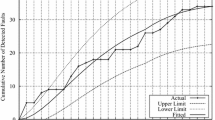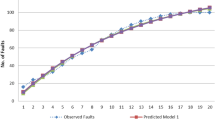Abstract
Software manufacturers need to minimize the number of their software failures in their production environments. So, software reliability becomes a critical factor for these manufacturers to focus on. Software Reliability Growth Models (SRGMs) are used as indicators of the number of failures that may be faced after the shipping of the software and thus are indicators of the readiness of the software for shipping. SRGMs to handle varying operational profiles have been proposed by researchers earlier. However, as it is difficult to predict the nature of the project in advance, the reliability engineer has to try out each model one at a time before zeroing in on the model to be used in the project. We have derived a combination model, called dynamically weighted infinite NHPP combination, using the existing models for determining the release time. The nonparametric dynamically weighted combination model that we propose was validated and was found to be effective.



Similar content being viewed by others
References
Tariq I et al (2018) The comprehensive study on software reliability. In: IEEE International Conference on Computing, Mathematics and Engineering Technologies, iCoMET
Musa JD (1999) Software reliability engineering. McGraw-Hill Publication, New York
Subburaj R (2015) Software reliability engineering. McGraw Hill Education (India)Private Limited, New Delhi, pp 61–80
Yamada S, Osaki S (1985) Software reliability growth modeling: models and applications. IEEE Trans Softw Eng SE-11(12):1431–1437
Subburaj R, Gopal G, Kapur PK (2007) A software reliability growth model for vital quality metrics. S Afr J Ind Eng 18(2):93–108
Goel AL (1985) Software reliability models: assumptions, limitations and applicability. IEEE Trans Softw Eng SE-11(12):1411–1423
Subburaj R, Gopal G, Kapur PK (2012) A software reliability growth model for estimating debugging and the learning indices. Int J Perform Eng 8(5):539–549
Farr W (1996) Software reliability modeling survey. McGraw-Hill, New York
Ramasamy S, Govindasamy G (2006) Generalized exponential Poisson model for software reliability growth. Int J Perform Eng 2(3):291–301
Ramasamy S, Govindasamy G (2006) A software reliability growth model addressing imperfect debugging and learning. In: Proceedings of International Conference on Reliability and Safety Engineering, pp 156–64
Gupta A et al (2019) Analysis of software reliability models for reliability estimation. In: IEEE 9th International Conference on Cloud Computing, Data Science and Engineering
Xiw M et al (2000) Software reliability models—past, present and future. In: Limmos, Nikulin M (eds.) Recent Advancement in Reliability Theory: Methodology Practise and Inference. Proceedings of International Conference on Mathematical Methods in Reliability (MMR 2000), France
Farr W (1996) Design and code inspections to reduce errors in program development. IBM Syst J 15(3):182–211
Goel AL (1985) Software reliability models: assumptions, limitations and applicability. IEEE Trans Softw Eng SE 11(12):1411–1423
The Guide to the Systems Engineering Body of Knowledge (SEBoK), v. 2.1, R.J. Cloutier (Editor in Chief) (2019). in SEBoK Editorial Board, Hoboken, NJ
Vidhyashree Nagaraju (2018) Software reliability assessment: modeling and algorithms. IEEE International Symposium on Software Reliability Engineering Workshops (ISSREW), pp166–169. https://doi.org/10.1109/ISSREW.2018.000-4
Ramasamy S, Preetha CASD (2016) Dynamically weighted combination model for describing inconsistent failure data of software projects. Indian J Sci Technol. https://doi.org/10.17485/ijst/2016/v9i35/90211
Preetha CASD, Ramasamy S (2016) Importance of release time determination for success in software development projects. Int J Control Theory Appl 9(40):819–825
Rotella P, Chulani S (2017) Predicting release reliability. In: IEEE International Conference on Software Quality, Reliability and Security Companion (QRS-C), pp 39–46
Garg R, Gupta A (2018) Prediction of optimum release time of software ensuring high achievable reliability. In: IEEE International Conference on Advances in Computing, Communication Control and Networking Technologies
Er-Qiang F, Jun Z (2017) A software reliability model based on failure mode. In: IEEE Fourth International Conference on Dependable Systems and Their Applications
Zhu Mengmeng, Pham Hoang (2018) A two-phase software reliability modeling involving with software fault dependency and imperfect fault removal. Comput Lang Syst Struct Elsevier 53:27–42
Kapur PK, Garg RB (1990) Optimal software release policies for software reliability growth models under imperfect debugging. RAIRO 24:295–305
Ramasamy Subburaj, Preetha CASD (2017) A new and repeatable methodology for estimating software stop testing time. Int J Pure Appl Math 116(23):145–155
Cao P, Yang K, Liu K (2019) Optimal selection and release problem in software testing process: a continuous time stochastic control approach. Elsevier Eur J Oper Res. https://doi.org/10.1016/j.ejor.2019.01.075
Rani P, Mahapatra GS (2019) A novel approach of NPSO on dynamic weighted NHPP model for software reliability analysis with additional fault introduction parameter. Heliyon, Elsevier, Amsterdam
Deiva Preetha CAS, Subburaj R (2018) Study on software reliability combination models. J Adv Res Dyn Control Syst 956–960
Li Q, Pham H (2019) A generalized software reliability model with consideration of the uncertainty of operating environments. IEEE Access 7:84253–84567
Musa JD, Ackerman AF (1989) Quantifying software validation: when to stop testing? IEEE Softw 6:19–27
Huang C-Y, Lyu MR (2005) Optimal testing resource allocation, and sensitivity analysis in software development. IEEE Trans Reliab 54(4):592–603
Kuo S-Y, Huang C-Y, Lyu MR (2001) Framework for modeling software reliability, using various testing-efforts and fault-detection rates. IEEE Trans Reliab 50(3):310–320
Musa JD (1980) DACS Software reliability dataset, data and analysis center for software [Internet]. Accessed from: http://www.dacs.dtic.mil/databases/sled/swrel.shtml. Accessed 19 Sept 2005
Author information
Authors and Affiliations
Corresponding author
Additional information
Publisher's Note
Springer Nature remains neutral with regard to jurisdictional claims in published maps and institutional affiliations.
Rights and permissions
About this article
Cite this article
Deiva Preetha, C.A.S., Ramasamy, S. Nonparametric dynamically weighted combination model to determine when to stop testing. J Supercomput 76, 6065–6082 (2020). https://doi.org/10.1007/s11227-019-03125-9
Published:
Issue Date:
DOI: https://doi.org/10.1007/s11227-019-03125-9




